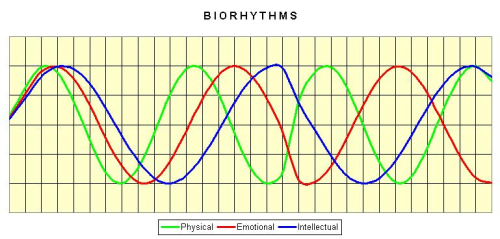
Biorhythm Theory (or "biorhythms" for short) states that each of us is influenced by several biological cycles, the main ones being our 'physical' cycle, 'emotional' cycle and 'intellectual' cycle. These begin at birth and continue throughout life. To compute the influence biorhythms might have for any particular day, all you need is the date of birth plus the appropriate mathematical calculations.
The physical cycle has 23 days, the emotional cycle 28 days and the intellectual cycle 33 days. From these cycles, you can predict what condition you'll be in on a given day.
The awkward part is to also take account of the 36-day aesthetic cycle, the 39-day intuitional cycle and the 57-day spiritual cycle.
Biorhythms also ignores exogenous cycles. These are cycles which affect us due to external factors, such as the weather, work, the economy, environment, health, food we eat, and all the other bits and pieces which make life so complex.
And perhaps the biggest external factor on our lives is our inter-relationship with other people who have completely different biological rhythms to our own. It's impossible to build these cycles into the biorhythmic model.
Biorhythms became popular in the 1970s, when, for a modest (or not too modest) fee, you could have your biorhythms ascertained by a professional biorhythms authority. The more technically savvy could buy a biorhythmic watch or a floppy disc for their Macintosh. Since the equations are quite simple, it wasn't long before free software became available on the internet.
The whole world of biorhythms turned into a circus. Entertaining? Maybe. Useful? Certainly not.
Modern medicine acknowledges that our hearts beat and we breathe to certain rhythms. They vary of course, but generally quite regular within a short range. We all enjoy (or suffer) a circadian rhythm, which cycles about once every day. Psychiatrists and neurologists have fancy names for other infradian rhythms such as circatrigintan (menstrual), circaseptan, circadiseptan, circavigintan and circannual.
Indeed, it's recognised that these periodic biological cycles do affect our physical and mental performance. But these cycles don't correspond to the so-called biorhythms. Our lives depend so much more on environmental factors and to focus on a personal biorhythms graph is to run the risk of looking in the wrong direction. And the results could be catastrophic. (Try telling the car insurance company that your biorythms dampened your concentration, and you tried to counter that by closing your eyes whilst driving because you can concentrate better with your eyes closed.)
We all have periodic biological cycles but there is no reason why these cycles should all begin on the day of one's birth, no evidence that they all develop at the same rate as we grow, nothing to say that the frequency is constant throughout our lives, and no evidence that everybody shares the same rates.
Traditional folklore linked madness to lunar phases (hence the word 'lunatic'). Now we understand more about things such as bipolar disorder. We can understand how mental illness is affected by genes and the environment. But there's no empirical evidence to suggest phases of the moon effect mood disorders. And that's rather convenient for us: Bipolar disorder can be treated with a mood stabilizing medication and psychotherapy. Changing the phases of the moon would be more of a challenge.
Today, very few people waste their time on biorhythms and dismiss it along with fortune telling.
As mentioned, biorhythms became popular in Japan, particularly during the global surge in interest during the 1970s and 1980s, but today, as in the West, they are considered largely outdated and not mainstream. This contrasts with more structured personality theories, such as blood type personality superstition which gained popularity in the 1970s and 1980s and is still culturally influential in Japan.
This difference in cultural persistence is due to a combination of social, cultural, psychological, and practical factors:
¶ As with UFO spotting and ouija board games, the biorhythms craze was as short-lived as crop circles. Biorythms might, however, have succeeded in providing us with the excuse for being late for work again!